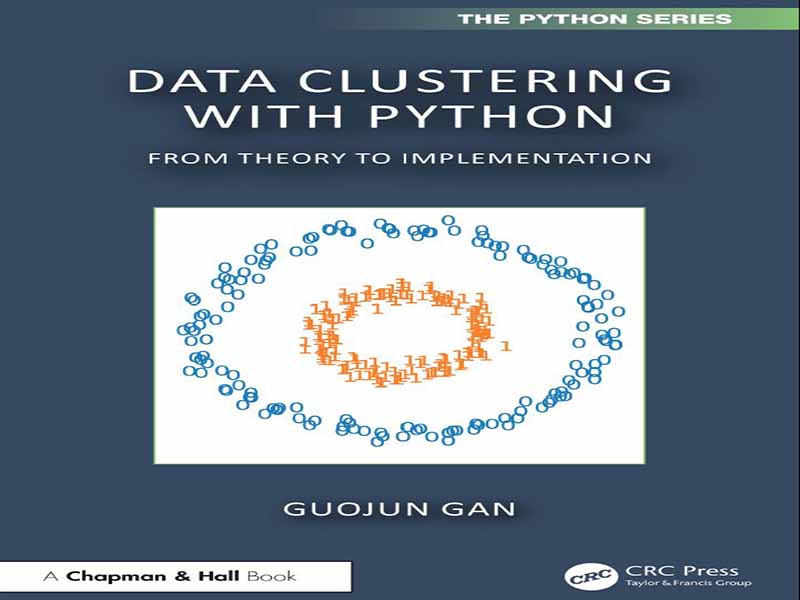- عنوان کتاب: Data Clustering with Python From Theory to Implementation
- نویسنده: Guojun Gan
- حوزه: تحلیل داده, برنامهنویسی پایتون
- سال انتشار: 2025
- تعداد صفحه: 260
- زبان اصلی: انگلیسی
- نوع فایل: pdf
- حجم فایل: 8.53 مگابایت
خوشهبندی دادهها، یک حوزه میانرشتهای با کاربردهای متنوع، از زمان پیدایش خود در دهه 1950 محبوبیت فزایندهای پیدا کرده است. در طول شش دهه گذشته، محققان از رشتههای مختلف الگوریتمهای خوشهبندی متعددی را پیشنهاد کردهاند. در سال 2011، من کتابی در مورد پیادهسازی الگوریتمهای خوشهبندی در ++C با استفاده از برنامهنویسی شیءگرا نوشتم. در حالی که ++C کارایی ارائه میدهد، منحنی یادگیری شیبدار آن، آن را برای نمونهسازی سریع ایدهآل نمیکند. از آن زمان، پایتون محبوبیت زیادی پیدا کرده و از سال 2022 به پرکاربردترین زبان برنامهنویسی تبدیل شده است. سادگی و کتابخانههای علمی گسترده آن، آن را به انتخابی عالی برای پیادهسازی الگوریتمهای خوشهبندی تبدیل کرده است. ویژگیها: • مقدمهای بر اصول برنامهنویسی پایتون • مروری بر مفاهیم کلیدی در خوشهبندی دادهها • پیادهسازی الگوریتمهای خوشهبندی محبوب در پایتون • مثالهای عملی از اعمال الگوریتمهای خوشهبندی در مجموعه دادهها • دسترسی به کد پایتون مرتبط در GitHub این کتاب با پیادهسازی الگوریتمهای خوشهبندی در پایتون، کار قبلی من را گسترش میدهد. برخلاف رویکرد شیءگرا در ++C، این کتاب از سبک برنامهنویسی رویهای استفاده میکند، زیرا پایتون امکان پیادهسازی مختصر بسیاری از الگوریتمهای خوشهبندی را فراهم میکند. این کتاب به دو بخش تقسیم شده است: بخش اول به معرفی پایتون و کتابخانههای کلیدی مانند NumPy، Pandas و Matplotlib میپردازد، در حالی که بخش دوم الگوریتمهای خوشهبندی، از جمله روشهای سلسله مراتبی و پارتیشنبندی را پوشش میدهد. هر فصل شامل توضیحات نظری، پیادهسازیهای پایتون و مثالهای عملی است و در صورت لزوم با scikit-learn مقایسه میشود. این کتاب برای هر کسی که به الگوریتمهای خوشهبندی علاقهمند است و نیازی به تجربه قبلی پایتون ندارد، ایدهآل است. کد منبع کامل در آدرس زیر موجود است: https://github.com/ganml/dcpython.
Data clustering, an interdisciplinary field with diverse applications, has gained increasing popularity since its origins in the 1950s. Over the past six decades, researchers from various fields have proposed numerous clustering algorithms. In 2011, I wrote a book on implementing clustering algorithms in C++ using object-oriented programming. While C++ offers efficiency, its steep learning curve makes it less ideal for rapid prototyping. Since then, Python has surged in popularity, becoming the most widely used programming language since 2022. Its simplicity and extensive scientific libraries make it an excellent choice for implementing clustering algorithms. Features: • Introduction to Python programming fundamentals • Overview of key concepts in data clustering • Implementation of popular clustering algorithms in Python • Practical examples of applying clustering algorithms to datasets • Access to associated Python code on GitHub This book extends my previous work by implementing clustering algorithms in Python. Unlike the object-oriented approach in C++, this book uses a procedural programming style, as Python allows many clustering algorithms to be implemented concisely. The book is divided into two parts: the first introduces Python and key libraries like NumPy, Pandas, and Matplotlib, while the second covers clustering algorithms, including hierarchical and partitional methods. Each chapter includes theoretical explanations, Python implementations, and practical examples, with comparisons to scikit-learn where applicable. This book is ideal for anyone interested in clustering algorithms, with no prior Python experience required. The complete source code is available at: https:// github.com/ganml/dcpython.
این کتاب را میتوانید از لینک زیر بصورت رایگان دانلود کنید:
Download: Data Clustering with Python From Theory to Implementation




































نظرات کاربران